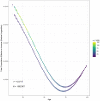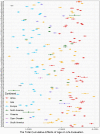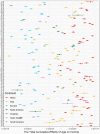Income raises human well-being indefinitely, but age consistently slashes it
- PMID: 37041218
- PMCID: PMC10090099
- DOI: 10.1038/s41598-023-33235-7
Income raises human well-being indefinitely, but age consistently slashes it
Abstract
The relationships among human well-being, income, and age have long been debated. The association between human well-being and income is believed to be U-shaped, although the reasons remain elusive. A recent study shows a turning point in the link between human well-being and income; that is, increased income does not always improve well-being. However, the mechanisms of the effects of income and age on human well-being are unknown. Here, we illustrate the total cumulative effects of income and age on evaluated well-being through all observed causal pathways based on a 1.6-million-observation global dataset and the structural causal model. This is the first study to investigate those casual relationships globally. We find that an increase in age always reduces evaluated well-being, and the adverse effects are aggravated with age. Furthermore, increased income continuously improves human well-being, but the impacts gradually become marginal with higher income. Our results demonstrate that physical health improvement in older people is the most effective way to intervene against the harmful effects of age on well-being. Moreover, increased income may dramatically enhance the well-being of people living close to the poverty line.
© 2023. The Author(s).
Conflict of interest statement
The authors declare no competing interests.
Figures












Similar articles
-
Quantifying reciprocal relationships between poverty and health: combining a causal loop diagram with longitudinal structural equation modelling.Int J Equity Health. 2024 May 1;23(1):87. doi: 10.1186/s12939-024-02172-w. Int J Equity Health. 2024. PMID: 38693575 Free PMC article.
-
Effects of guaranteed basic income interventions on poverty-related outcomes in high-income countries: A systematic review and meta-analysis.Campbell Syst Rev. 2024 Jun 16;20(2):e1414. doi: 10.1002/cl2.1414. eCollection 2024 Jun. Campbell Syst Rev. 2024. PMID: 38887375 Free PMC article. Review.
-
Pathways into chronic multidimensional poverty amongst older people: a longitudinal study.BMC Geriatr. 2016 Mar 7;16:62. doi: 10.1186/s12877-016-0236-z. BMC Geriatr. 2016. PMID: 26951685 Free PMC article.
-
Crowding out and impoverishing effect of tobacco in Mexico.Tob Control. 2024 Jun 4;33(Suppl 2):s68-s74. doi: 10.1136/tc-2022-057791. Tob Control. 2024. PMID: 37567601 Free PMC article.
-
The Minderoo-Monaco Commission on Plastics and Human Health.Ann Glob Health. 2023 Mar 21;89(1):23. doi: 10.5334/aogh.4056. eCollection 2023. Ann Glob Health. 2023. PMID: 36969097 Free PMC article. Review.
Cited by
-
A healthful plant-based diet is associated with higher health-related quality of life among older adults independent of circulating CRP: a cross-sectional analysis from the Lifelines Cohort Study.J Nutr Sci. 2025 Aug 4;14:e54. doi: 10.1017/jns.2025.10023. eCollection 2025. J Nutr Sci. 2025. PMID: 40838262 Free PMC article.
-
Detecting Non-linear Dependence through Genome Wide Analysis.bioRxiv [Preprint]. 2025 Feb 13:2025.02.12.637804. doi: 10.1101/2025.02.12.637804. bioRxiv. 2025. PMID: 39990333 Free PMC article. Preprint.
-
Association Between Income and Well-Being Among Working Women in Japan.Healthcare (Basel). 2025 Jan 24;13(3):240. doi: 10.3390/healthcare13030240. Healthcare (Basel). 2025. PMID: 39942431 Free PMC article.
-
Equation Built by Multiple Adaptive Regression Spline to Estimate Biological Age in Healthy Postmenopausal Women in Taiwan.Diagnostics (Basel). 2025 Apr 30;15(9):1147. doi: 10.3390/diagnostics15091147. Diagnostics (Basel). 2025. PMID: 40361964 Free PMC article.
References
Publication types
MeSH terms
LinkOut - more resources
Full Text Sources

